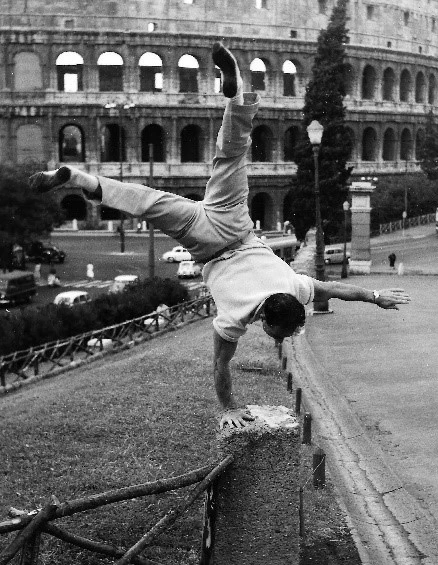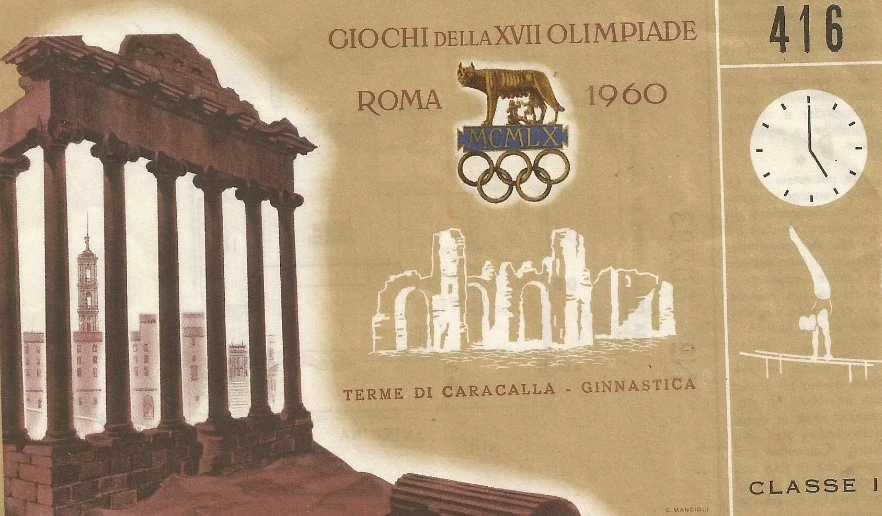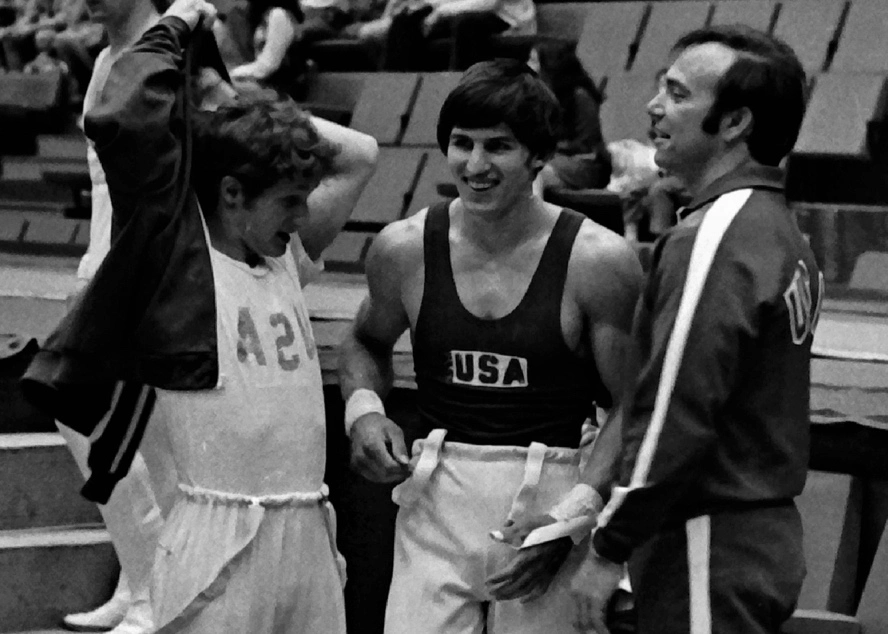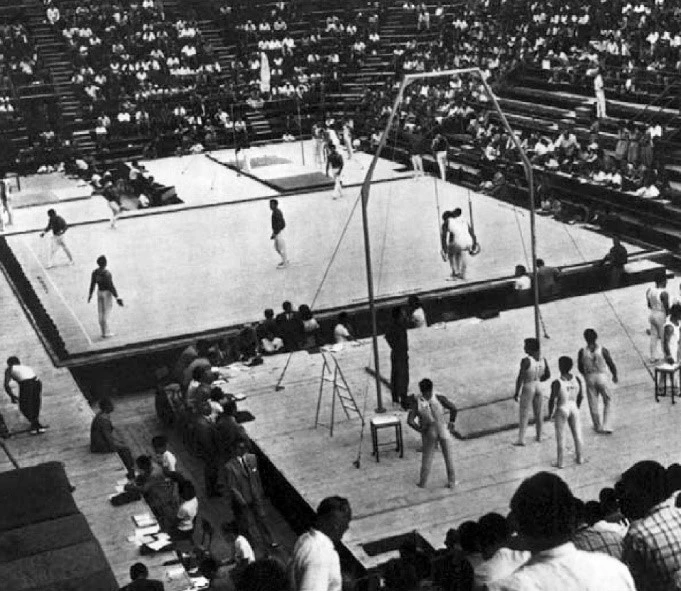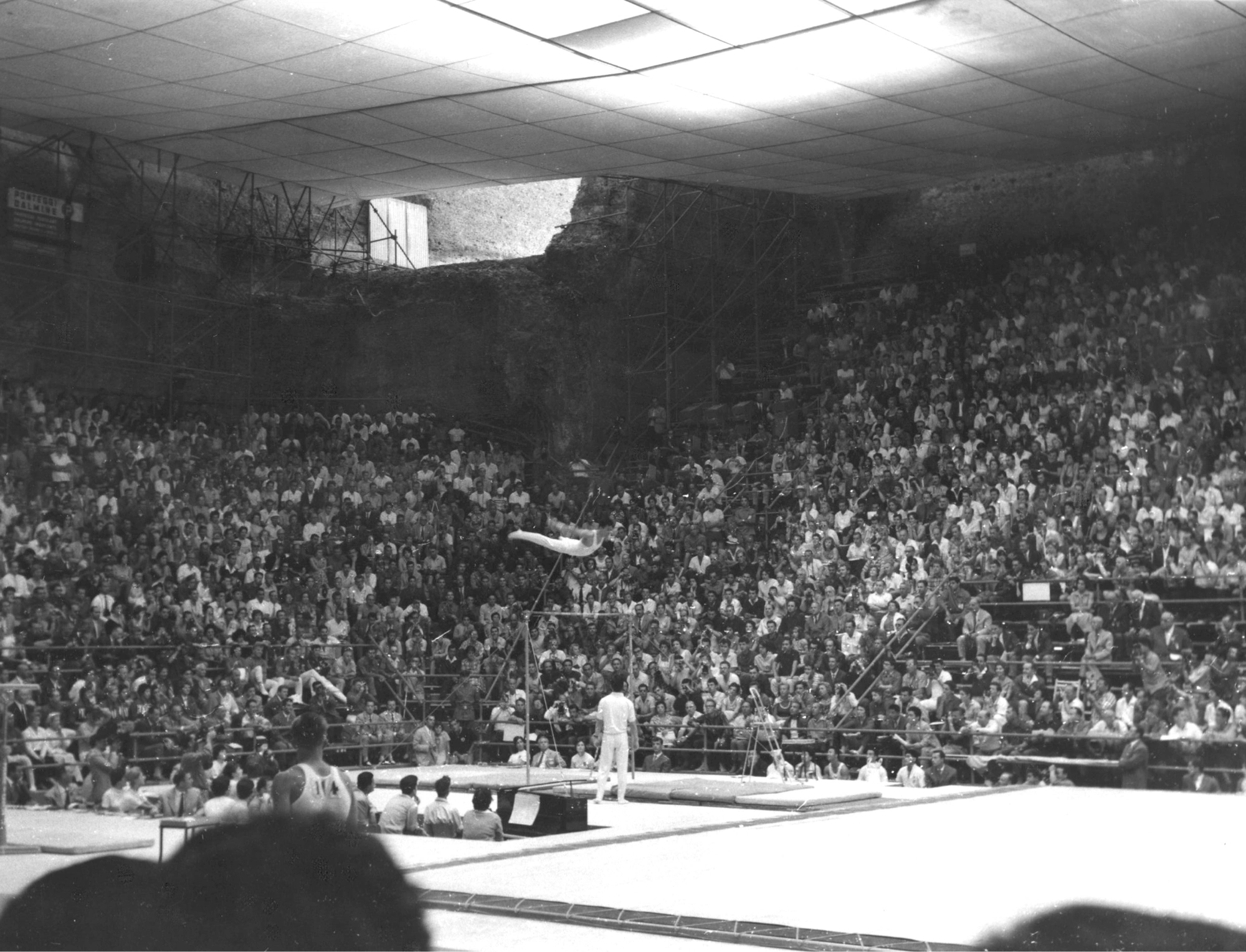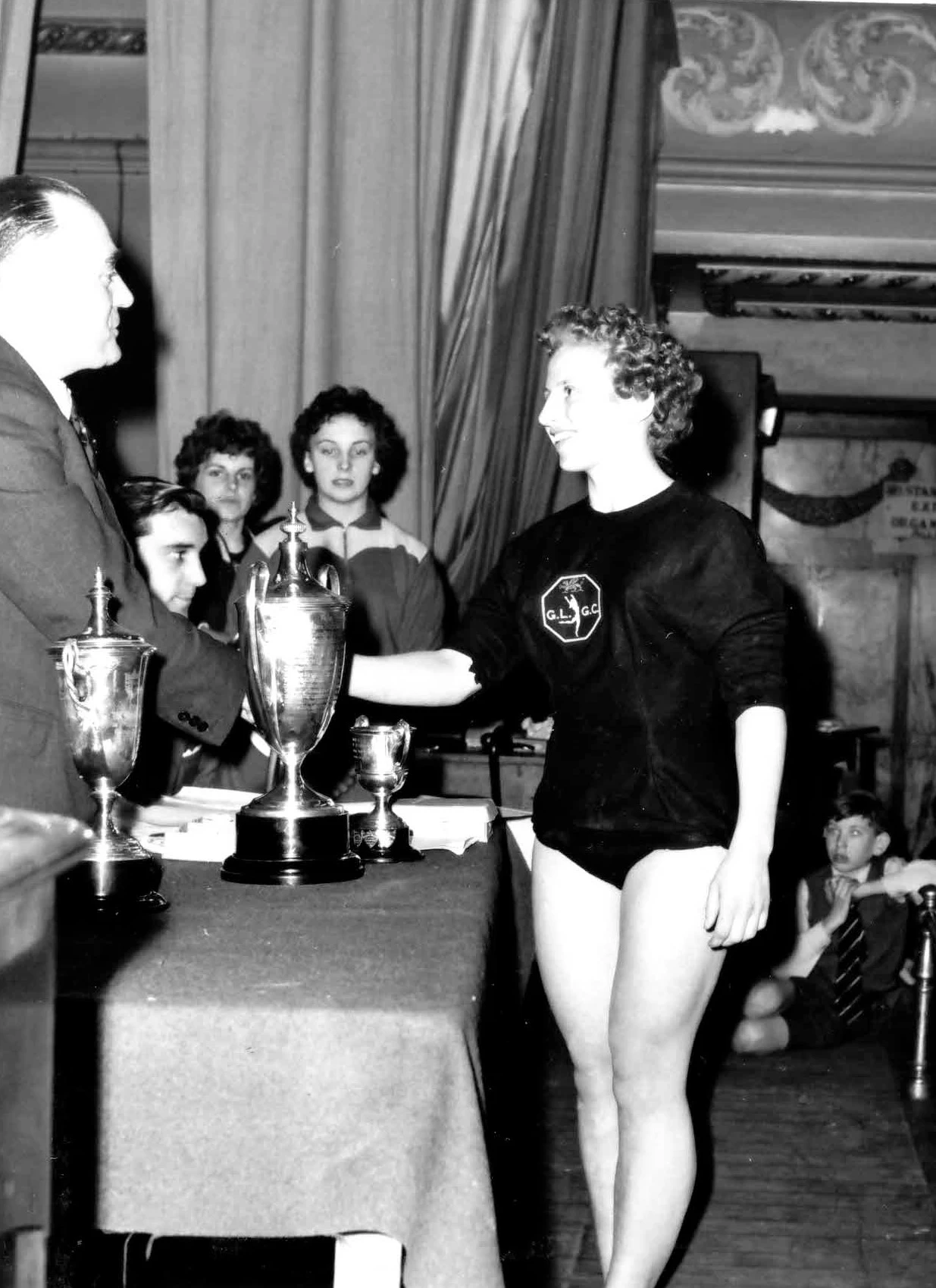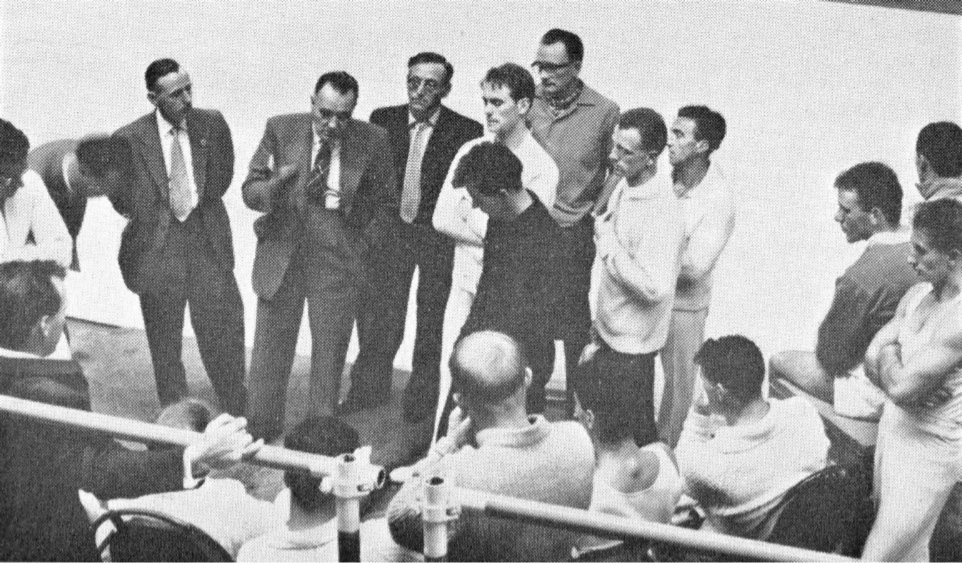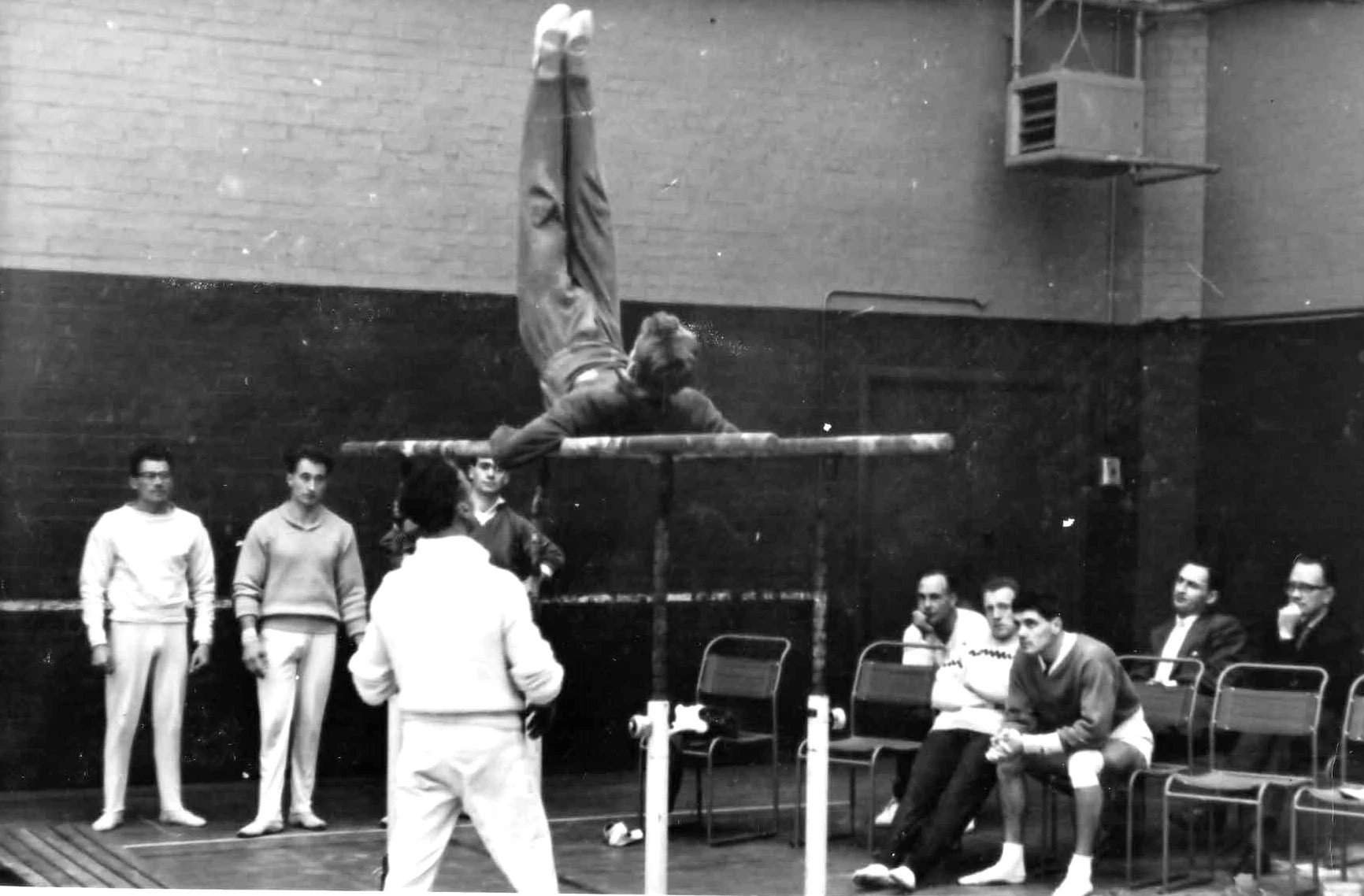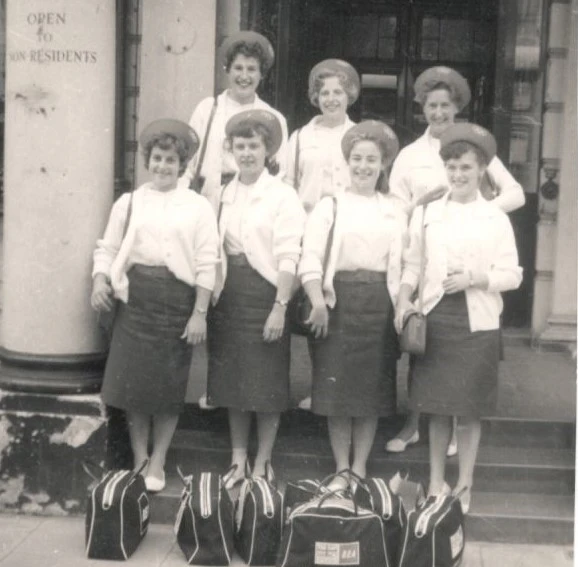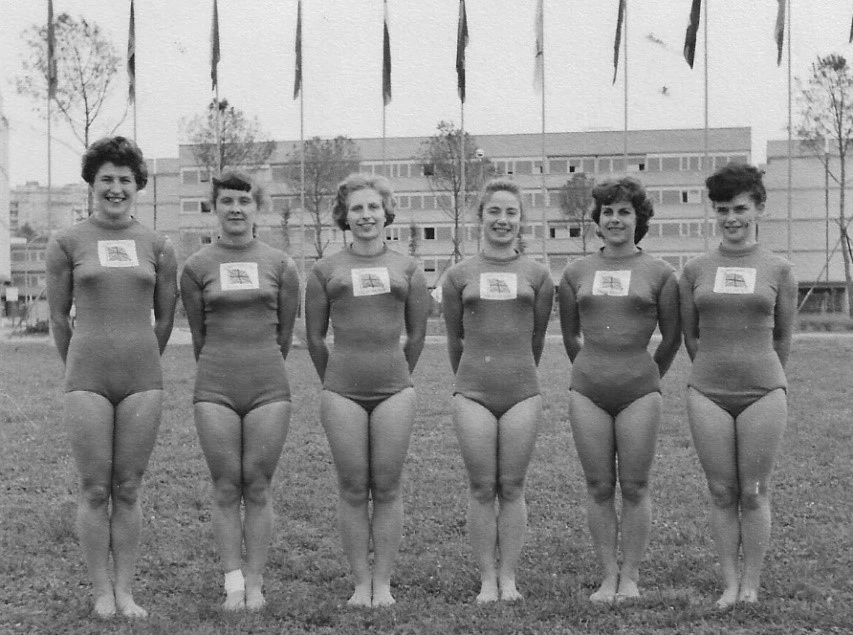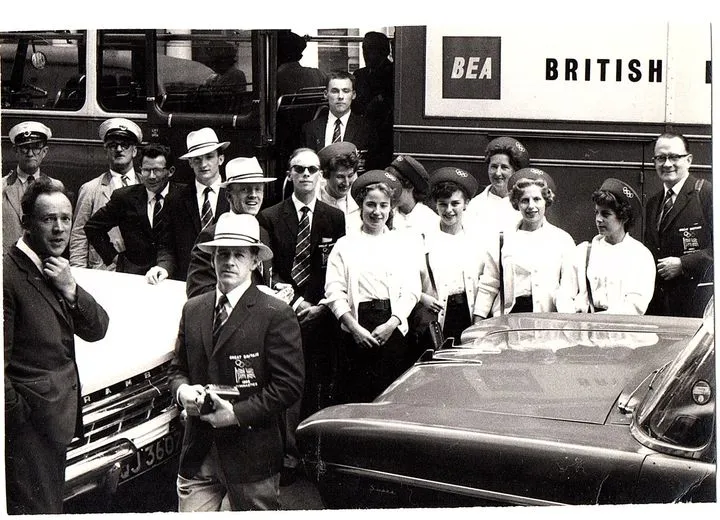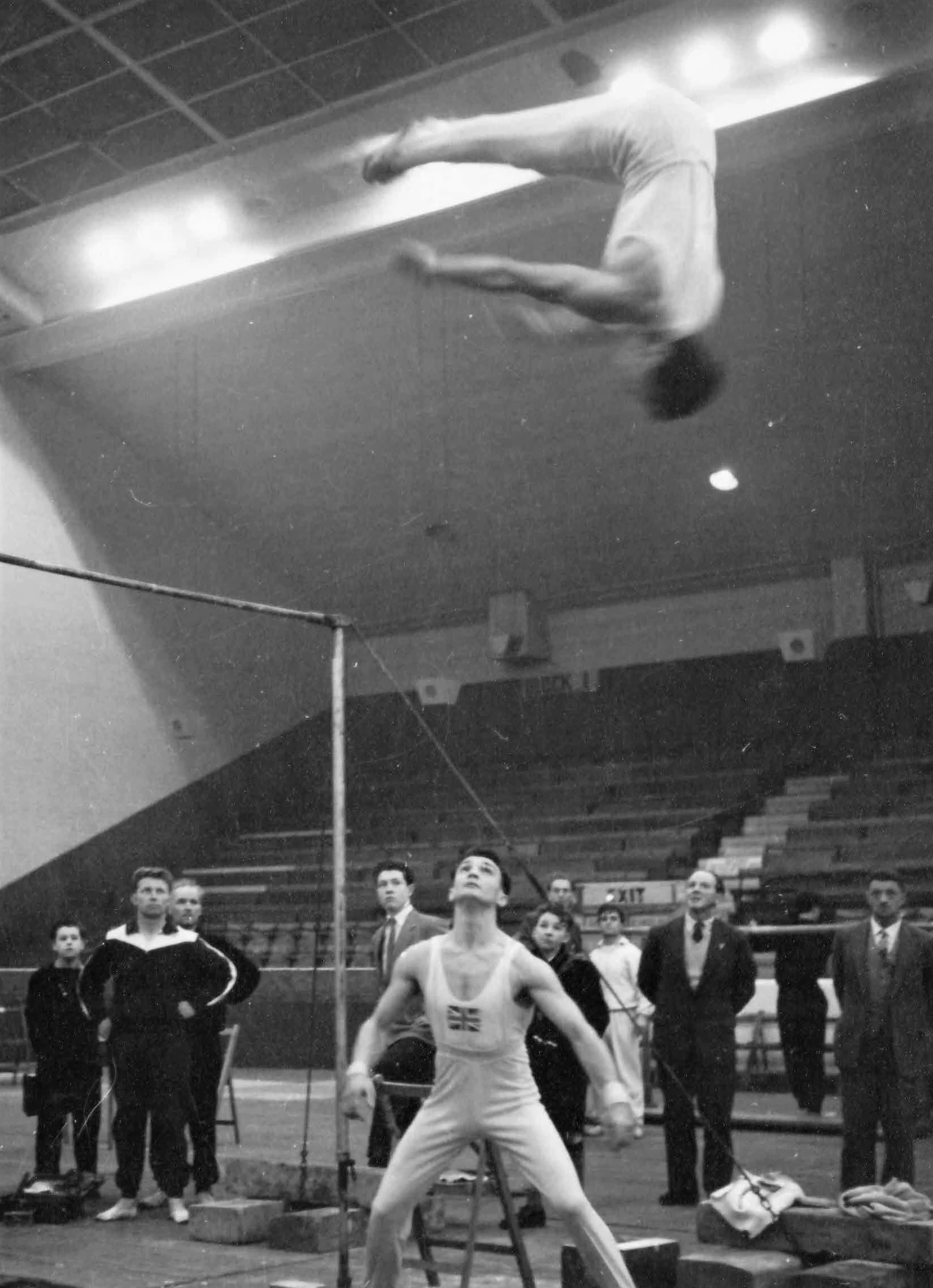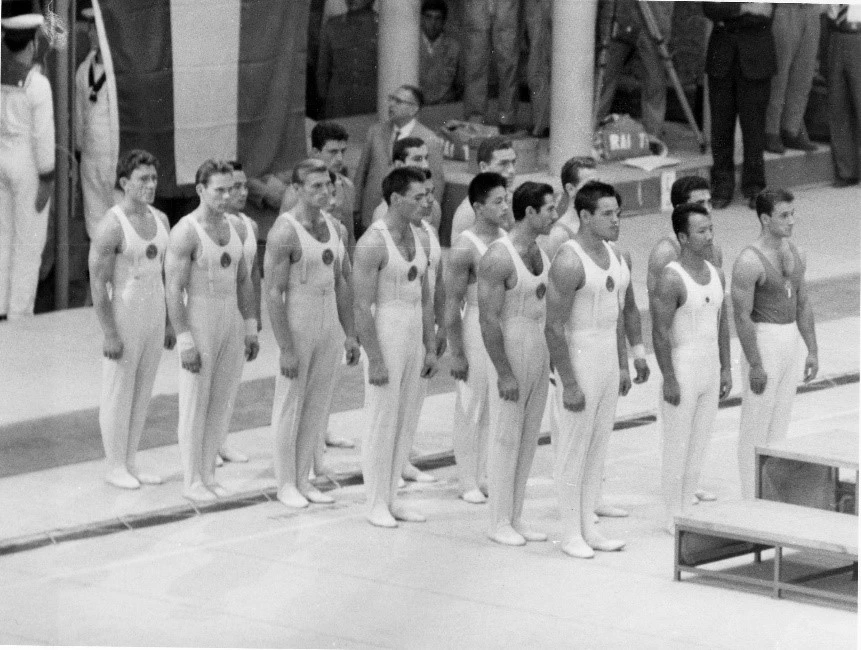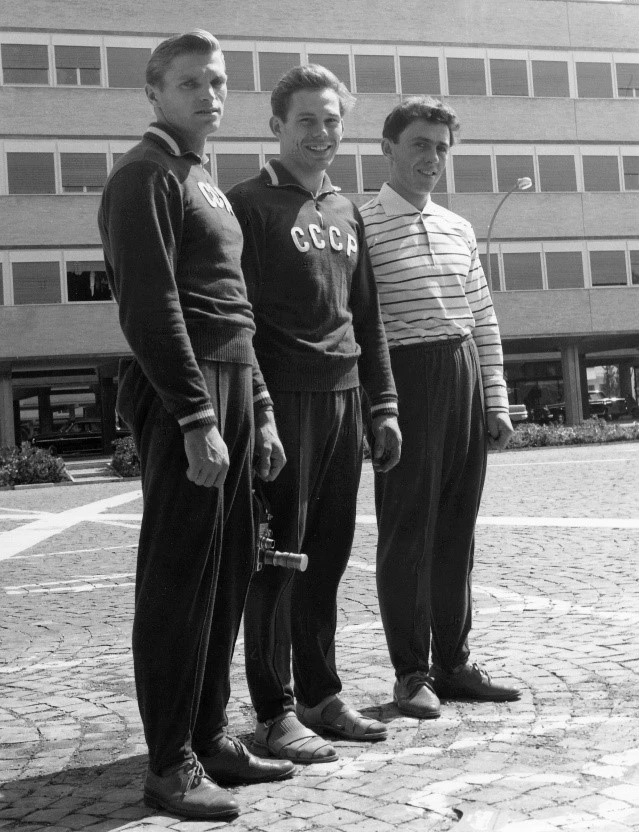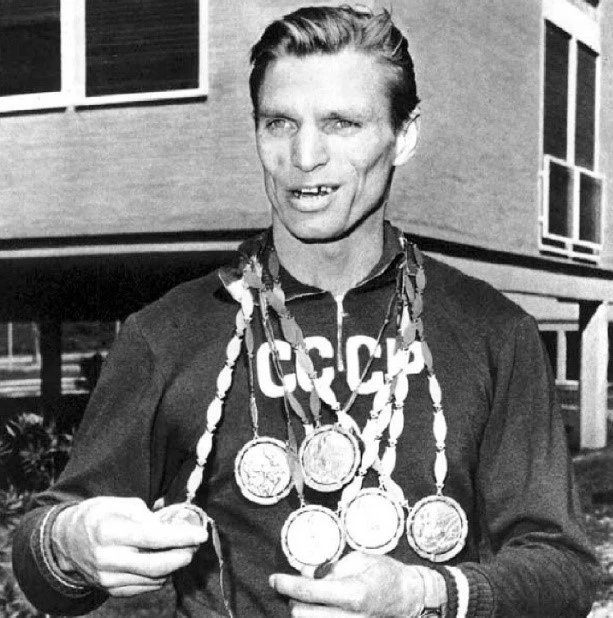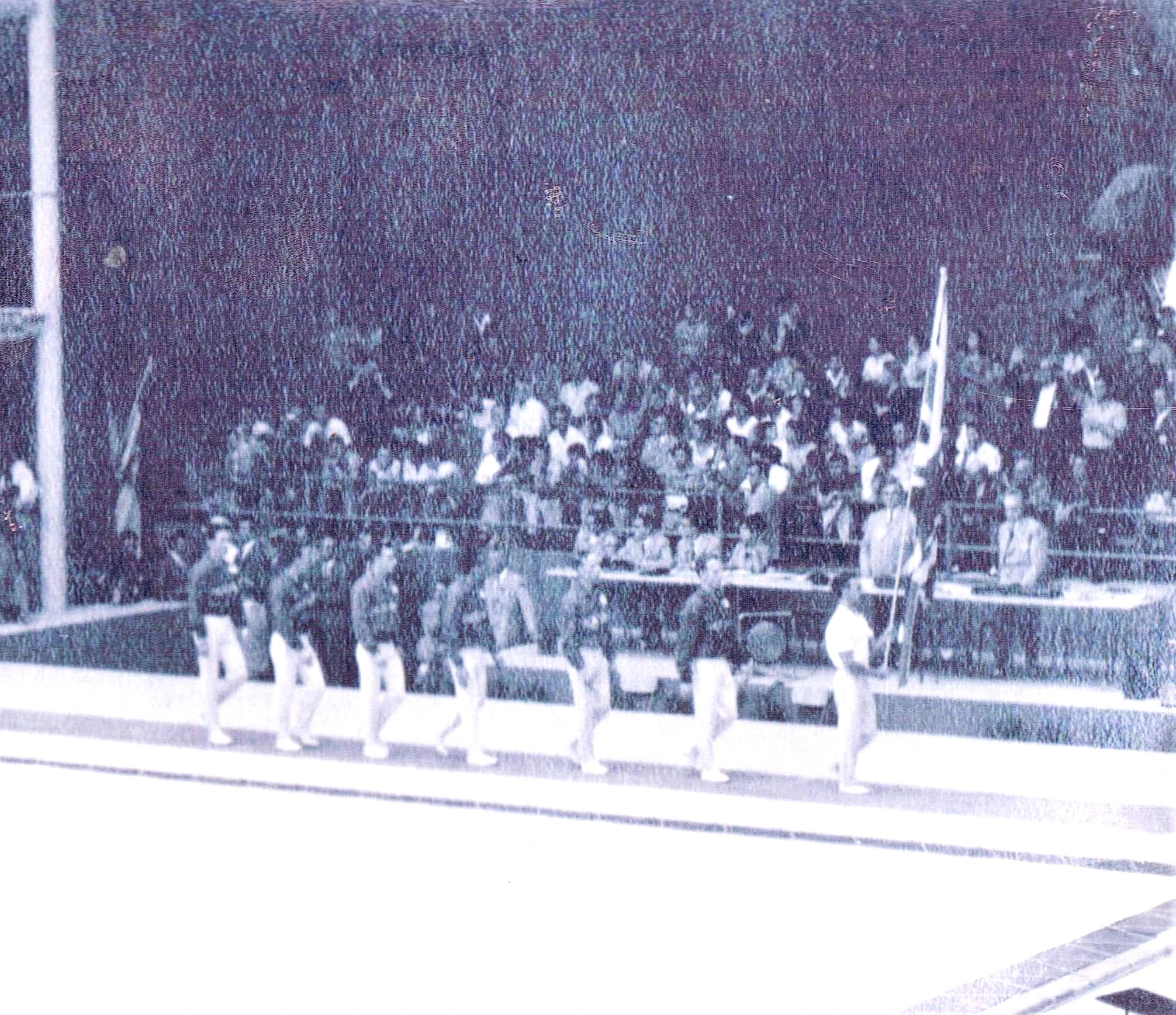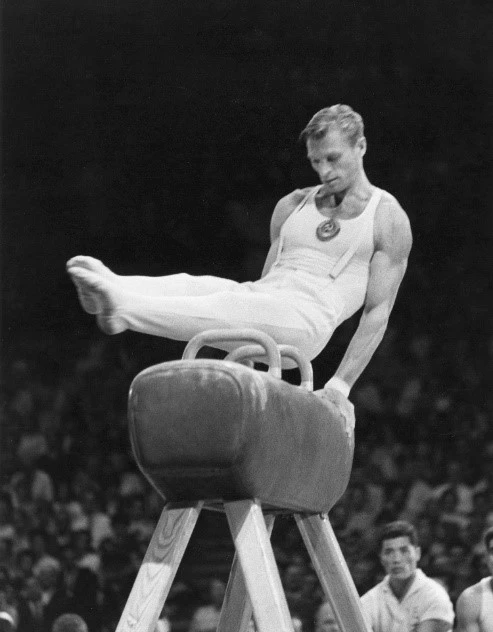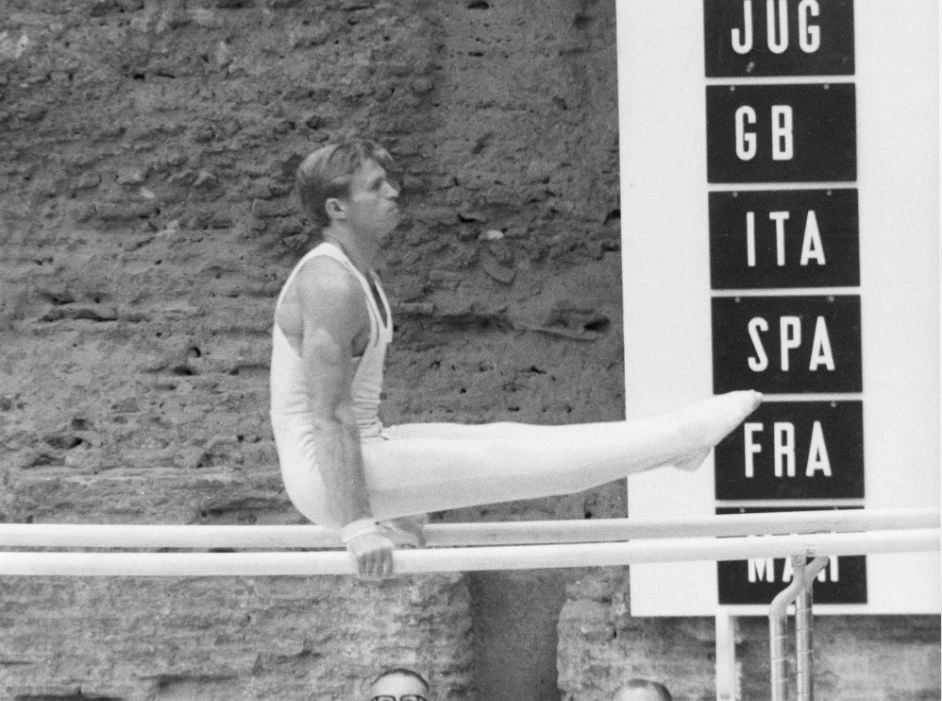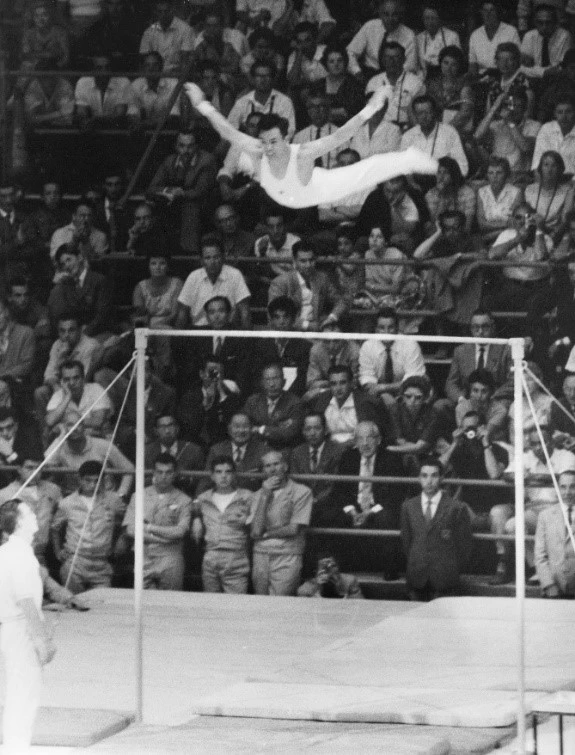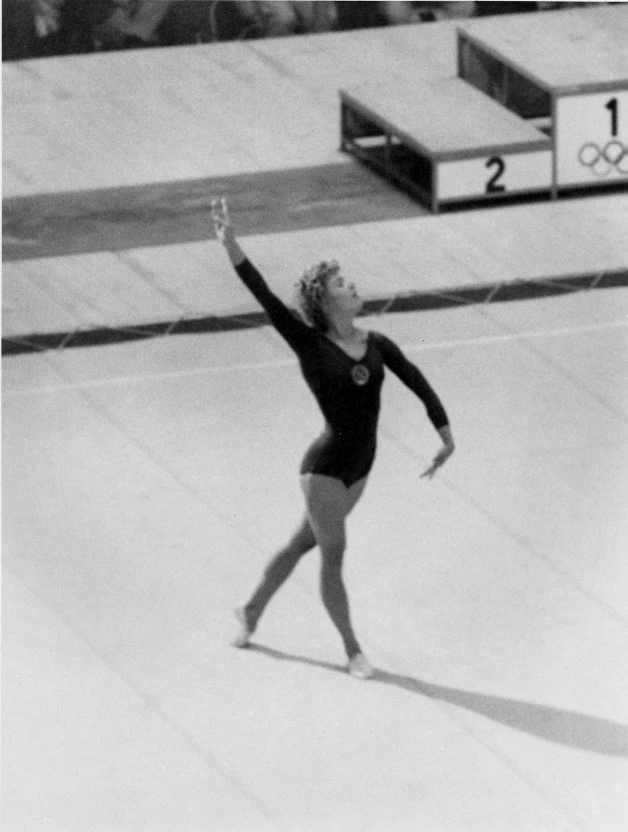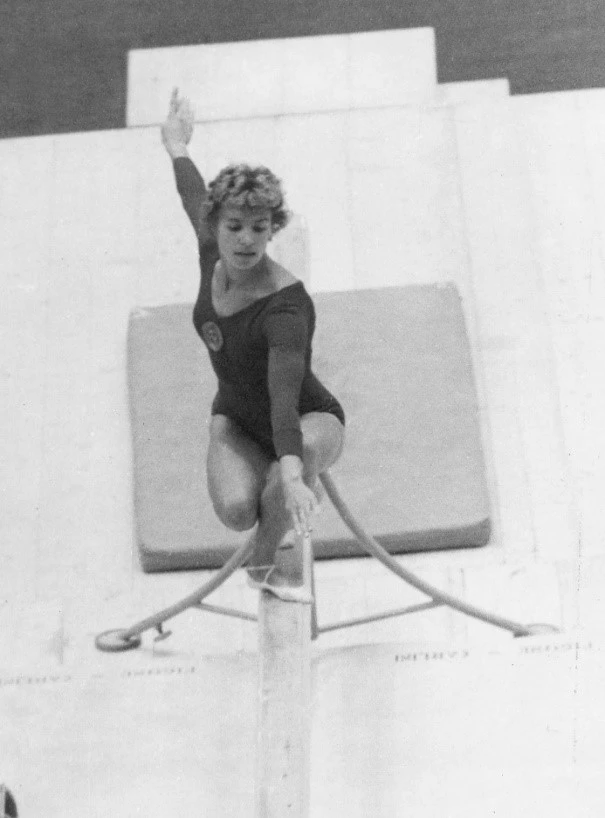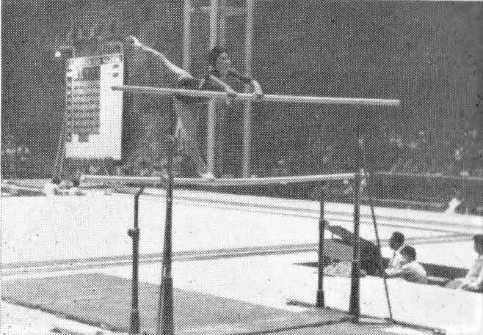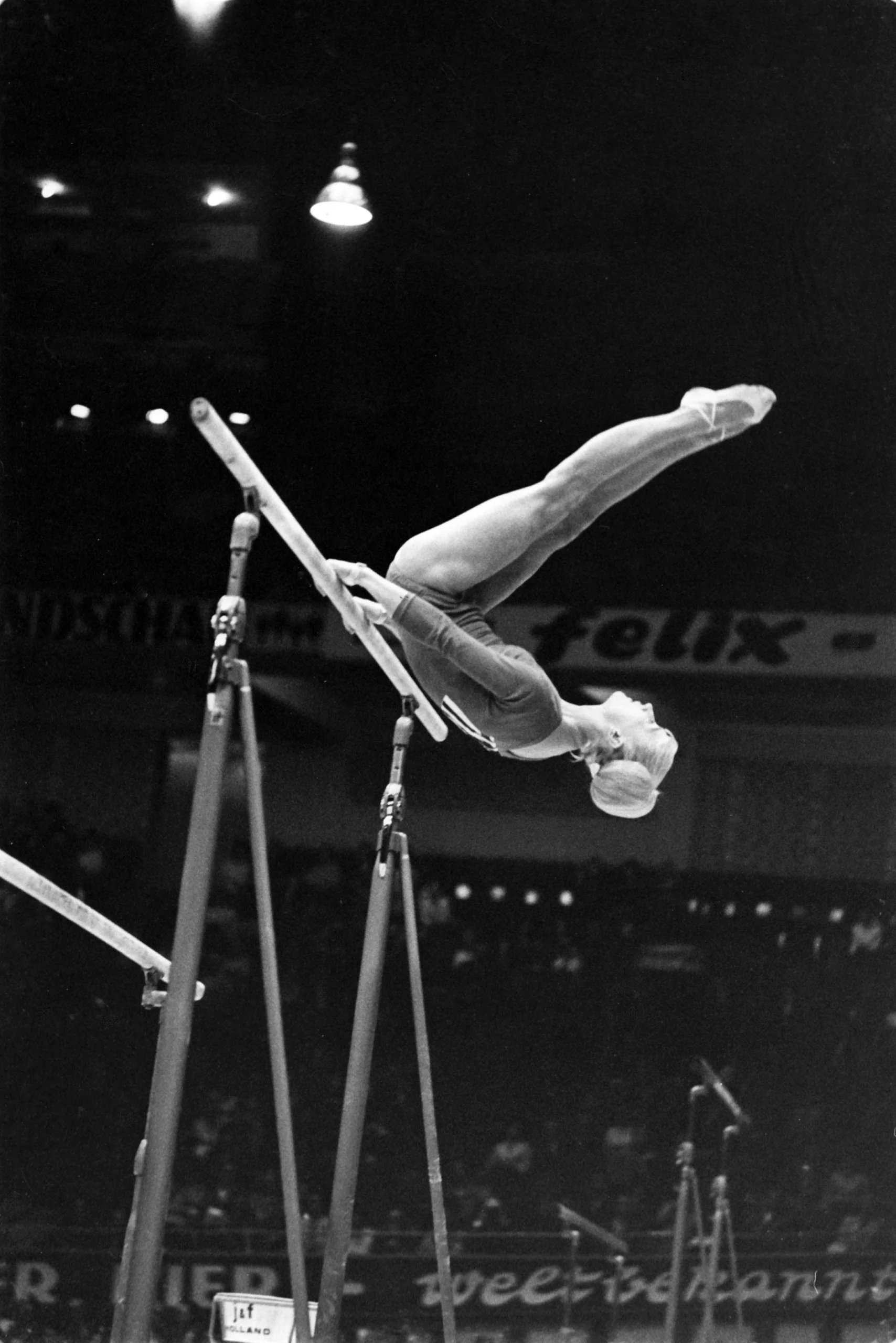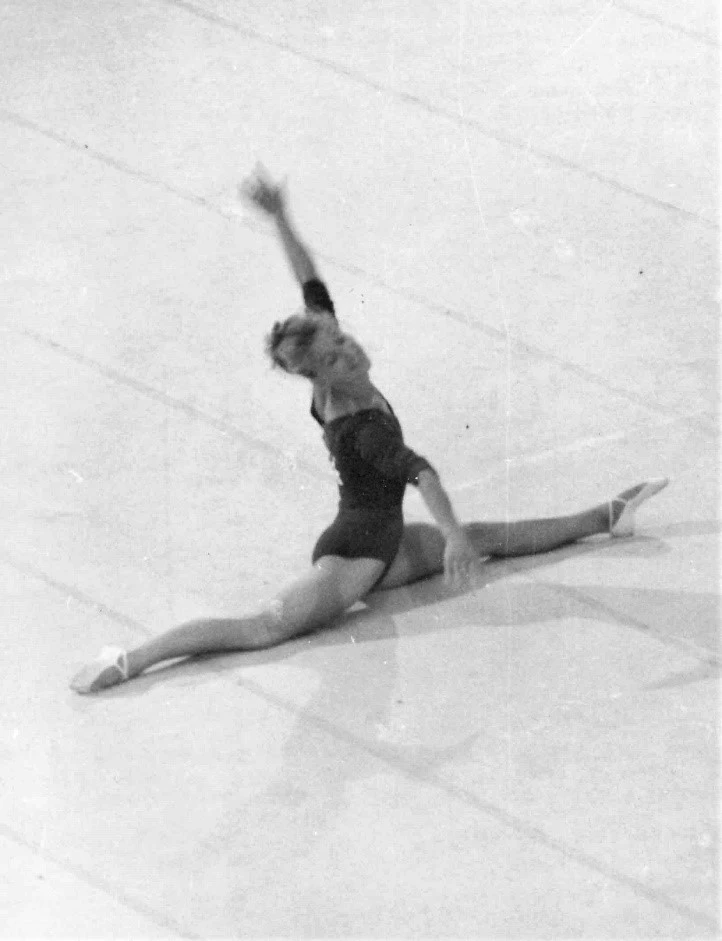OLYMPIC REPORT
1960
Rome
The gymnastics was held from the 5th to the 10th of September in the Terme de Caracalla, Rome – an amazing venue for gymnastics.
The Caracalla layout of the arena set a benchmark for future gymnastic events. In 1958 some members of the FIG had their doubts about the suitability of the Caracalla as the gymnastic venue; how wrong they were.
Photo – Albert Azaryan peforming his ‘Azeryan Cross’ on Rings in the Rome 1960 Olympic Games – photo Alan Burrows / International Gymnast
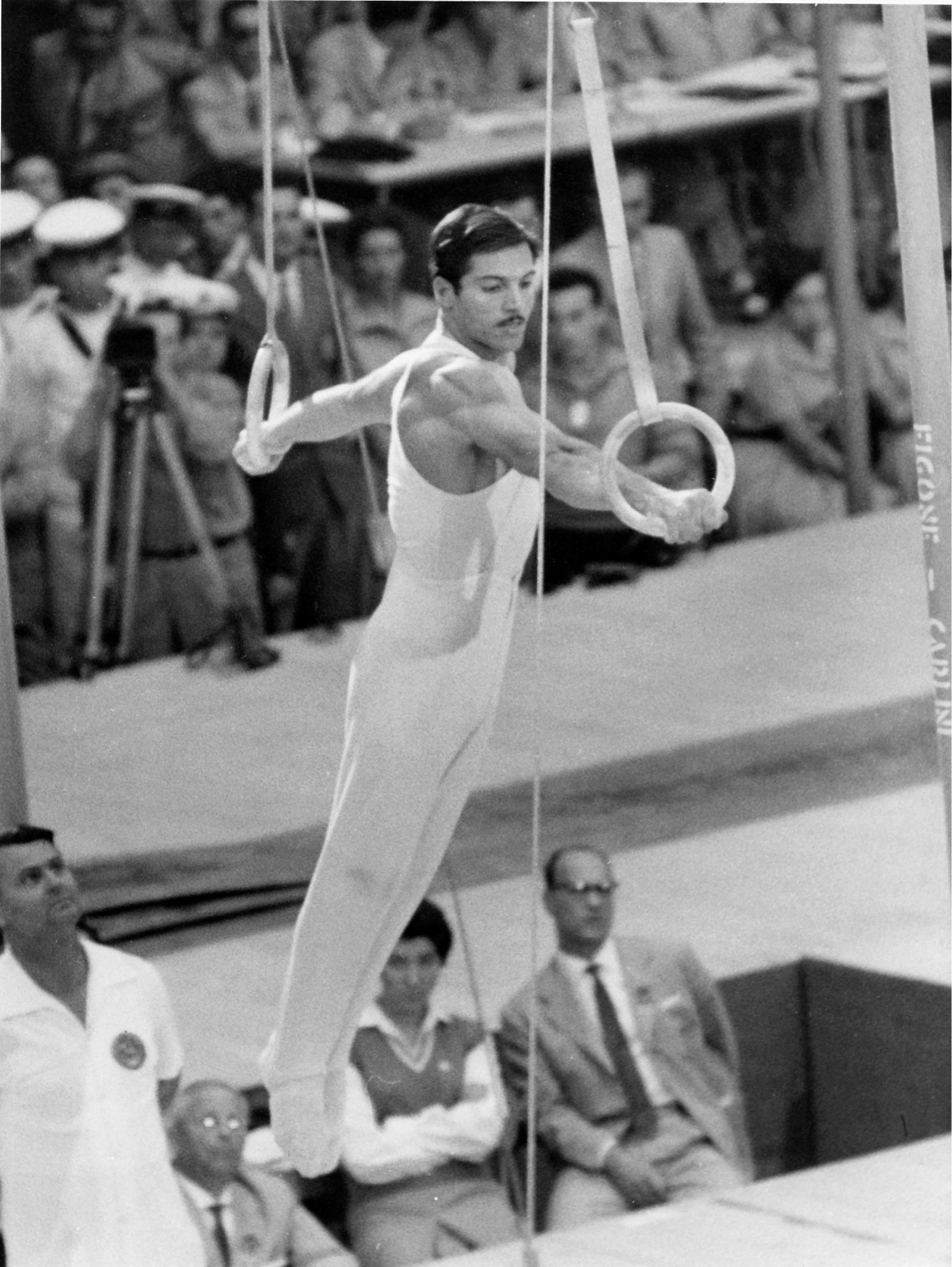
At a glance
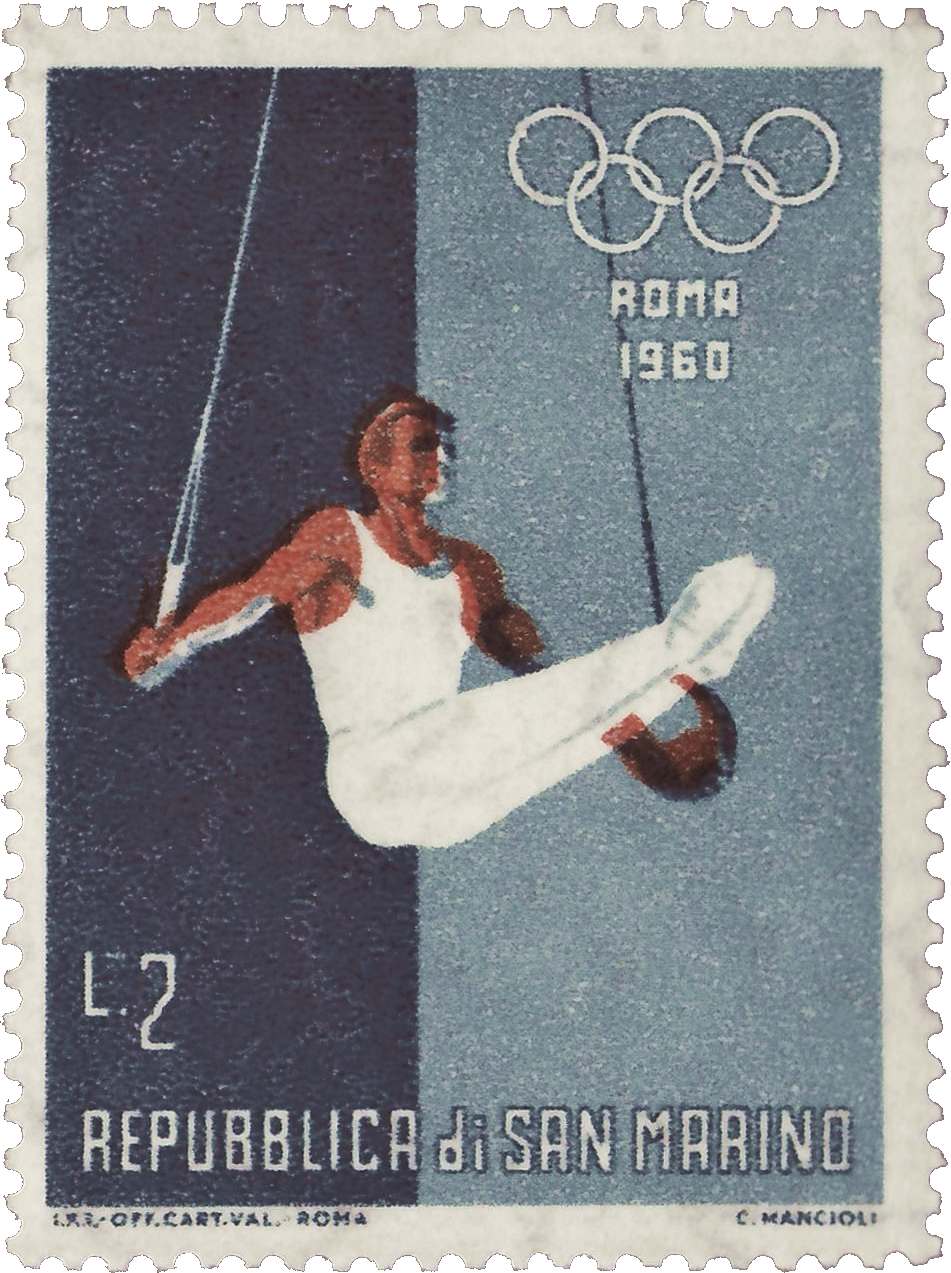
130 male gymnasts took part along with 124 women gymnasts coming from a record 33 countries.
This was possibly the first time that gymnastics could be viewed by so many on TV. Jim Prestidge wrote that the film of gymnastics was shown several times on the BBC as there were so many requests for repeats.
Some research was done on the height and weight of competing athletes. The gymnasts came in as the shortest and lightest, averaging for men, 168.87cm tall and 65.16 kilos. For the women, it was 159.16cm and 53.42 kilos. The only other athletes that came close to this were the high board women divers. There was also a breakdown of these measurements over continents. The Asians were by far the shortest and lightest, which is not surprising. It would be interesting to see if these figures went down for the women in the 70’s and 80’s when Olga Korbut first made her appearance and the age limit for the female gymnast was 15 in the year of competition. (In the modern day this is 16 in the year of competition).
Sadly, both of the British teams were outclassed as this was the Olympics where the new era was evident for all to see, the artistry of the Soviets, Czechs and Japanese, emphasised by the fact that all 6 members of a team could be counted in the final placings. In the Individual all-around women, 1 – 4 in the overall results showed all Soviet gymnasts, and the same for asymmetric bars. With the men in the all-around 5 Japanese gymnasts appeared in the top 7, and in the vault final the event was taken over by the Japanese and Soviets.
For Meg Warren (Gymnastics History’s curator), as a 15-year-old already steeped in gymnastics, it was thrilling to see so many outstanding gymnasts who went beyond anything that had been seen previously.
The photos that were taken at the Games were breathtaking, mostly due to the skill of British photographer and gymnast Alan Burrows. Alan, when asked some years later, which was the best Games that he went to; Rome was the answer. There was no heavy security at that time, it was so relaxed. Alan thought the venue was perfect as the lighting was so good; photographers are always worried about lighting. Alan remembered the amazing superiority of the Russians and the Japanese which was to dominate the men’s events.
These games were an eye-opener to all the British gymnasts and fans of gymnastics.
USA legend Abie Grossfeld recalls
“Two married gymnastics couples at the 1960 OG were Takashi and Kiyoko Ono and Muriel and Abie Grossfeld. One of the news services took us around to various Rome sites, shooting many photos of us. That was fun. Also, Muriel and I were chosen as female and male Olympic athlete representatives to go to a press conference at Gina Lollobrigida’s mansion on the Appian Way. Rock Hudson was there for the release of his and Gina’s movie, Come September. Also, I met Gina’s husband (at the time) who had been a gymnast in Yugoslavia”. This was Abie’s 2nd Olympic Games, he attended 8 more as a coach or official.
FIG INNOVATIONS
In 1957, the German Democratic Republic, after 7 attempts was finally admitted to the FIG. There was a compromise as the GFR and the GDR appeared as a combined team.
The women’s team floor exercise was finally removed from the programme and the women, at last, were able to embark upon the programme that we see in the modern era. It was 24 years since the men settled into their six Olympic apparatus. Now the women would have the same assurance that their programme would remain the same.
All gymnasts were required to do compulsory exercises on the first day and optional exercises on the second for the qualification which would decide the overall individual placings and the team results. There was an option for the gymnasts to repeat their compulsory performance if they made a mistake. This they had to do immediately. This innovation was first introduced at the 1948 Olympics. Several gymnasts took this option including Titov on pommels and Shakhlin on parallels. Nik Stuart also took the opportunity twice, firstly on vault after a fall and then on parallel bars. These facts have only come to light with the recent scanning of the George Kunzle Rome films; some clips are shown here later.
The format was day one – men’s compulsories, day two – women’s compulsories, day three – men’s optionals and on the fourth day – women’s optionals.
From each two days of competition, the top 6 on each piece of apparatus went through to the apparatus final. This was the first time that there had been a separate event for the individual apparatus. The gymnasts’ carry-over scores for set and voluntary were averaged then added to their final apparatus score in the final. There were five judges for the women and the middle three marks were averaged, so the final marks were often strange. The men’s competitions had 4 judges so averaging the middle 2 was not a problem.
From each two days of competition, the top 6 on each piece of apparatus went through to the apparatus final. This was the first time that there had been a separate event for the individual apparatus. The gymnasts’ carry-over scores for set and voluntary were averaged then added to their final apparatus score in the final. There were five judges for the women and the middle three marks were averaged, so the final marks were often strange. The men’s competitions had 4 judges so averaging the middle 2 was not a problem.
The Individual apparatus finals were held on the 9th for the women and the 10th of September for the men.
There is now a definite pattern and structure to the gymnastic events. The podium is now part of the competition organisation from now on.
British qualification
A full team of men and women represented GB.
The selection for the women was at the British Championships at Shoreditch Town Hall where Denise Goddard of Cardiff Olympic came 2nd but because she was only 14 she could not be selected for the games. Incidentally, this town hall at the time was very basic with the gymnasts working on a wooden floor with mats placed around for landing.
Pat Perks 1960 at Shoreditch Town Hall receiving her British Championships’ trophy. In the background is Denise Goddard waiting for her 2nd place medal with Gwynedd Lingard, 3rd place. William Clayton Bolt, Chairman of the AGA, making the presentation with Jim Wright, coach to Frank Turner, assisting. Everyone had to muck in and help in these days.
Women’s British Championships in 1960 -Pat Perks winning with Gwynedd Lingard and Denise Goddard looking on – Photo Jim Prestidge
From the photo, it looks as though the men’s trial was held at Stanmore Arena. Here William Clayton Bolt [Bill Bolt], talks to the possible team members.
Training at Lilleshall. Colin Beynon on the bars, withdrew from Olympic training to have money for the purchase of a house for himself and his wife, ex gymnast Heather Jones, and soon-to-be mother of Carl Beynon.
British Representation
Team Managers
Len Gross and Isabel Walshaw
Judges Bill Bolt from London and Audrey Bates from Swansea
Coaches Edna Gross and Frank Turner (both coaches had to pay their own expenses)
Women
Gwynedd Lingard nee Lewis – Grange Ladies coached by Cecil Guy
Pat Perks, Grange Ladies – coached by Cecil Guy
Margaret Neale nee Thomas – Cardiff Olympic, coached by Walter Maidment
Marjorie Carter nee Raistrick – Salts Saltaire, coached by Olympian Pat Hirst
Jill Pollard (later Coulton then Livingstone) – Saltaire, coached by her mother Carrie Pollard
Dorothy Summers – Mynachdy, South Wales, coached by father Cliff Summers
British Representation
Men
Nik Stuart – Army Gymnastics Union (AGU), coached by Tom Slaven
Ken Buffin – Cardiff Central Boys Club, coached by Bill Buffin (this was Ken’s 3rd Olympics)
Peter Starling – Norwich Priory
Dick Gradley – AGU, coached by Nik Stuart
Jack Pancott – AGU, coached by Nik Stuart
John Mulhall – Cardiff Central Boys Club, coached by Bill Buffin
THE RESULTS
MEN’S TEAM
| RANK | COUNTRY | TOTAL SCORE |
|---|---|---|
| 1 | JPN | 575.2 |
| 2 | RUS | 572.2 |
| 3 | ITA | 559.05 |
| 4 | CZE | 557.15 |
| 5 | USA | 555.2 |
| 6 | FIN | 554.45 |
| 7 | GER | 553.35 |
| 8 | SUI | 551.45 |
| 19 | GBR | 338.00 |
There is no fairy tale here. Once again, Great Britain were outclassed.
A comment from The Gymnast magazine at the time
“Even more difficult is our task, lack of facilities and a state of mind which is so short-sighted as to be suicidal”
MEN’S ALL AROUND
USSR Gymnasts L-R Boris Shakhlin, Yuri Titov and Vladimir Portnoi – photo Alan Burrows / International Gymnast
| RANK | NAME | COUNTRY | TOTAL SCORE |
|---|---|---|---|
| 1 | Boris Shakhlin | URS | 115.95 |
| 2 | Takashi Ono | JPN | 115.9 |
| 3 | Yuri Titov | URS | 115.6 |
| 4 | Shuji Tsurumi | JPN | 114.55 |
| 5 | Yukio Endo | JPN | 114.45 |
| 6 | Masao Takemoto | JPN | 114.45 |
| 7 | Nobuyuki Aihara | JPN | 114.4 |
| 8 | Miroslav Cerar | YUG | 114.25 |
| 55 | 55 Nik Stuart | GBR | 108.80 |
| 99 | Dick Gradley | GBR | 101.75 |
| 102 | Jack Pancott | GBR | 101.15 |
| 112 | John Mulhall | GBR | 97.65 |
| 114 | Ken Buffin | GBR | 95.65 |
| 128 | * Peter Starling | GBR | 57.70 |
*Peter Starling broke his foot after optional vault so didn’t complete the next 5 apparatus.
Soviet gymnast Boris Shakhlin with his medal haul of 4 gold, 2 silver, and 1 bronze medal – photo Olympic Report
GB team marching into the arena – Dick Gradley, Nik Stuart, John Mulhall, Peter Starling, Jack Pancott, (maybe) Frank Turner, the coach with flag. – Photo contributed
The amazing Boris Shakhlin appeared in 5 finals. He was later a familiar face at international competitions, judging for the Soviet Union.
Alan Burrows’ highlights were
“The Japanese on parallel bar set exercise with each man pipping the man before, Carminucci on parallel bars with his under somersault to handstand, his flying back roll to handstand and ½ swing turn to handstand, and the other Italian Menichelli on the floor performing his breathtaking arabian dive roll.”
Disappointment as far as Alan was concerned that the amazing pommel worker that Miroslav Cerar of Yugoslavia missed out on the final by one place.
On the vault, the most popular option was the long arm overthrow, or handspring, and the long fly, hecht but they were done with such flight and height as to appear more spectacular than before.
For Frank Turner, the highlights of the Games were
“Ono collecting his 2nd gold medal on the high bar and that spectacular dismount and the performances of 43-year-old Takemoto, who found so much enjoyment in everything he did. The greatest ovation was when he received his silver medal on the high bar.”
MEN’S FLOOR FINAL
Nobuyuki Aihara – of Japan winning gold on the Floor Exercise at the Rome Olympics in 1960 – film courtesy of George Kunzle family
| RANK | NAME | COUNTRY | TOTAL SCORE |
|---|---|---|---|
| 1 | Nobuyuki Aihara | JPN | 19.45 |
| 2 | Yuri Titov | URS | 19.325 |
| 3 | Franco Menchelli | ITA | 19.275 |
| 4 | Takashi Mitsukuri | JPN | 19.2 |
| 4 | Takashi Ono | JPN | 19.2 |
| 6 | Jaroslav Stastny | CZE | 19.05 |
MEN’S POMMEL HORSE
Alan Burrows wrote
“This heart-breaking piece of apparatus, the downfall of so many gymnasts provided no obstacles to the Russians and Japanese, who, working like a perfect team went through their sequences with amazing continuity. The Japanese did slightly more difficult work at the expense of some style. What a pleasant surprise to see the Finn, Ekman break the Russo-Japanese monopoly and share the gold medal with Shakhlin.”
Nik Stuart – of Great Britain performimg his set Pommel Horse Exercise at the Rome Olympics in 1960 – film courtesy of George Kunzle family
| RANK | NAME | COUNTRY | TOTAL SCORE |
|---|---|---|---|
| 1 | Eugen Ekmann | FIN | 19.375 |
| 1 | Boris Shakhlin | URS | 19.375 |
| 3 | Shuji Tsurumi | JPN | 19.15 |
| 4 | Takashi Mitsukuri | JPN | 19.125 |
| 5 | Yuri Titov | URS | 18.95 |
| 6 | Takashi Ono | JPN | 18.525 |
MEN’S RINGS FINAL
| RANK | NAME | COUNTRY | TOTAL SCORE |
|---|---|---|---|
| 1 | Albert Azaryan | URS | 19.725 |
| 2 | Boris Shakhlin | URS | 19.500 |
| 3 | Velik Kapsazov | BUL | 19.425 |
| 3 | Takashi Ono | JPN | 19.425 |
| 5 | Nobuyuki Aihara | JPN | 19.400 |
| 6 | Yuri Titov | URS | 19.275 |
MEN’S VAULT FINAL
| RANK | NAME | COUNTRY | TOTAL SCORE |
|---|---|---|---|
| 1 | Takashi Ono | JPN | 19.350 |
| 1 | Boris Shakhlin | URS | 19.350 |
| 3 | Vladimir Portnoi | URS | 19.225 |
| 4 | Yuri Titov | URS | 19.200 |
| 5 | Yukio Endo | JPN | 19.175 |
| 6 | Shuji Tsurumi | JPN | 19.150 |
MEN’S PARALLEL BARS FINAL
| RANK | NAME | COUNTRY | TOTAL SCORE |
|---|---|---|---|
| 1 | Boris Shakhlin | URS | 19.400 |
| 2 | Giovanni Carminucci | ITA | 19.375 |
| 3 | Takashi Ono | JPN | 19.350 |
| 4 | Nobuyuki Aihara | JPN | 19.275 |
| 5 | Yuri Titov | URS | 19.200 |
| 6 | Masao Takemoto | JPN | 19.125 |
MEN’S HIGH BAR FINAL
Japanese Gymnast – Takashi Ono’s dismount at the 1960 Rome Olympics Games – photo Alan Burrows / International Gymnast
| RANK | NAME | COUNTRY | TOTAL SCORE |
|---|---|---|---|
| 1 | Takashi Ono | JPN | 19.600 |
| 2 | Masao Takemoto | JPN | 19.525 |
| 3 | Boris Shakhlin | URS | 19.475 |
| 4 | Yukio Endo | JPN | 19.425 |
| 5 | Mirolslav Cerar | YUG | 19.400 |
| 6 | Yuri Titov | URS | 19.400 |
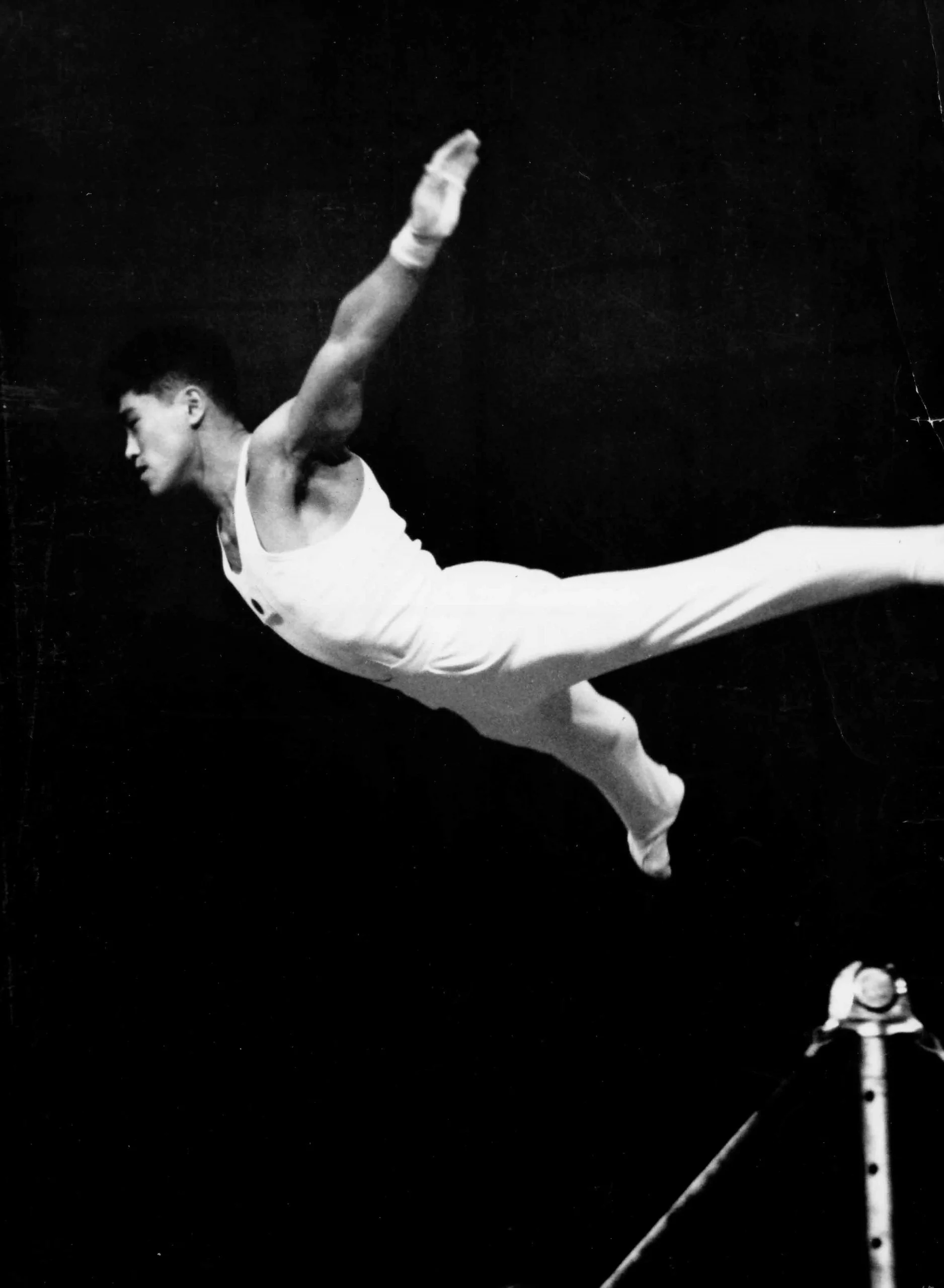
Yukio Endo’s Hecht dismount from the High Bar – photo Alan Burrows / International Gymnast
WOMEN’S TEAM FINAL
Once again, the Soviets dominated this competition. The German team under the banner of a combined Germany consisted of all East German gymnasts.
A very disappointing result for the British teams; men and women. The Gymnast magazine (British publication) reported
“Our country has a great deal to learn from these Games, and so much hard work is ahead to reach the standard set by the Russians, the Japanese and the Continentals’ When one looks at the training facilities at this time it is not surprising that we were so far behind, but it would take many years for us to catch up.”
| RANK | COUNTRY | TOTAL SCORE |
|---|---|---|
| 1 | URS | 382.320 |
| 2 | CZE | 373.323 |
| 3 | ROM | 372.053 |
| 4 | JPN | 371.422 |
| 5 | POL | 368.620 |
| 6 | GER | 367.754 |
| 7 | HUN | 367.054 |
| 8 | BUL | 364.920 |
| 17 | GBR | 297.721 |
WOMEN’S ALL-AROUND FINAL
| RANK | NAME | COUNTRY | TOTAL SCORE |
|---|---|---|---|
| 1 | Larissa Latynina | URS | 77.031 |
| 2 | Sofia Muratova | URS | 76.696 |
| 3 | Polina Astakhova | URS | 76.164 |
| 4 | Marharyta Nikolayeva | URS | 75.831 |
| 5 | Sonia Iovan | ROM | 75.797 |
| 6 | Keiko Ikeda | JPN | 75.696 |
| 7 | Lidiya Ivanova | URS | 75.431 |
| 8 | Vera Caslavska | CZE | 75.298 |
| 103 | Gwynedd Lingard | GBR | 61.03 |
| 107 | Pat Perks | GBR | 59.931 |
| 108 | Margaret Neale | GBR | 59.398 |
| 110 | Marjorie Carter | GBR | 58.463 |
| 117 | Jill Pollard | GBR | 54.630 |
| 118 | Dorothy Summers | GBR | 54.365 |
Larissa Latynina – 1960 Olympic AA Champion competing on floor – photo Alan Burrows / International Gymnast
WOMEN’S VAULT FINAL
| RANK | NAME | COUNTRY | TOTAL SCORE |
|---|---|---|---|
| 1 | Marharyta Nikolayeva | URS | 19.316 |
| 2 | Sofia Muratova | URS | 19.049 |
| 3 | Larissa Latynina | URS | 19.016 |
| 4 | Adolfina Tacova | CZE | 18.783 |
| 5 | Sonia Iovan | ROM | 18.766 |
| 6 | Polina Astakhova | URS | 18.716 |
WOMEN’S UNEVEN BARS FINAL
| RANK | NAME | COUNTRY | TOTAL SCORE |
|---|---|---|---|
| 1 | Polina Astakhova | URS | 19.616 |
| 2 | Larissa Latynina | URS | 19.416 |
| 3 | Tamara Lyukhina | URS | 19.399 |
| 4 | Sofia Muratova | URS | 19.382 |
| 5 | Keiko Ikeda | JPN | 19.333 |
| 6 | Sonia Iovan | ROM | 19.099 |
In Rome, in 1960, it was evident this static style of bar work was on its way out – photo Alan Burrows / International Gymnast
The style of Uneven Bars work shown was on the way out. Most of the Soviets included back upstarts, seat circles and wrap the low bar to catch the high bar. Astakhova who worked with such pace also included a dislocation and a wrap hecht with ¼ turn to dismount.
Pauline Prestidge observed
“they used the apparatus as a skilled (male) gymnast would use 2 horizontal bars placed together.”
WOMEN’S BEAM FINAL
| RANK | NAME | COUNTRY | TOTAL SCORE |
|---|---|---|---|
| 1 | Eva Bosakova | CZE | 19.283 |
| 2 | Larissa Latynina | URS | 19.233 |
| 3 | Sofia Muratova | URS | 19.232 |
| 4 | Marharyta Nikolayeva | URS | 19.183 |
| 5 | Keiko Ikeda | JPN | 19.132 |
| 6 | Vera Caslavska | CZE | 19.083 |
WOMEN’S FLOOR FINAL
| RANK | NAME | COUNTRY | TOTAL SCORE |
|---|---|---|---|
| 1 | Larissa Latynina | URS | 19.583 |
| 2 | Polina Astakhova | URS | 19.532 |
| 3 | Tamara Lyukhina | URS | 19.449 |
| 4 | Eva Bosakova | CZE | 19.383 |
| 5 | Sofia Muratova | URS | 19.349 |
| 6 | Sonia Iovan | ROM | 19.232 |
Ingrid Fost – of Germany performing her voluntary Floor Exercise at the Rome Olympics in 1960 – film courtesy of George Kunzle family
All the floor exercises had to be accompanied by music; it had to be a single instrument so the piano was the instrument of choice. At major events at this time, a piano would be in place for live playing. This is one of the rare occasions that the British team had their own pianist.
For Nik Stuart, one of his highlights was seeing the best full twisting somersault by a woman – Muriel Grossfeld of the States.
The Gymnast magazine reports
“The floor exercises were brilliant, showing in most gymnasts, the poise of a well-trained ballet dancer together with the skill of the complete acrobat. The forward and backward walkovers without allowing the hands to touch the floor were numerous (we had never seen a free walkover before and couldn’t imagine how this was performed).”
Reflections
on Rome
The 1960 Rome Olympics was a wake-up call for all British gymnasts, coaches and officials. It was official; we were way behind the rest of the world. For the next forty years or so, we were to struggle, although there some glimmers of hope on the way.
Those gymnasts were pioneers, working under extremely difficult conditions with little or no funding and no technical or scientific support. Sacrifices were made but no one recognised them at the time. We remember them with pride.
Swedish Gymnast on Beam – photo credit Alan Burrows / International Gymnast
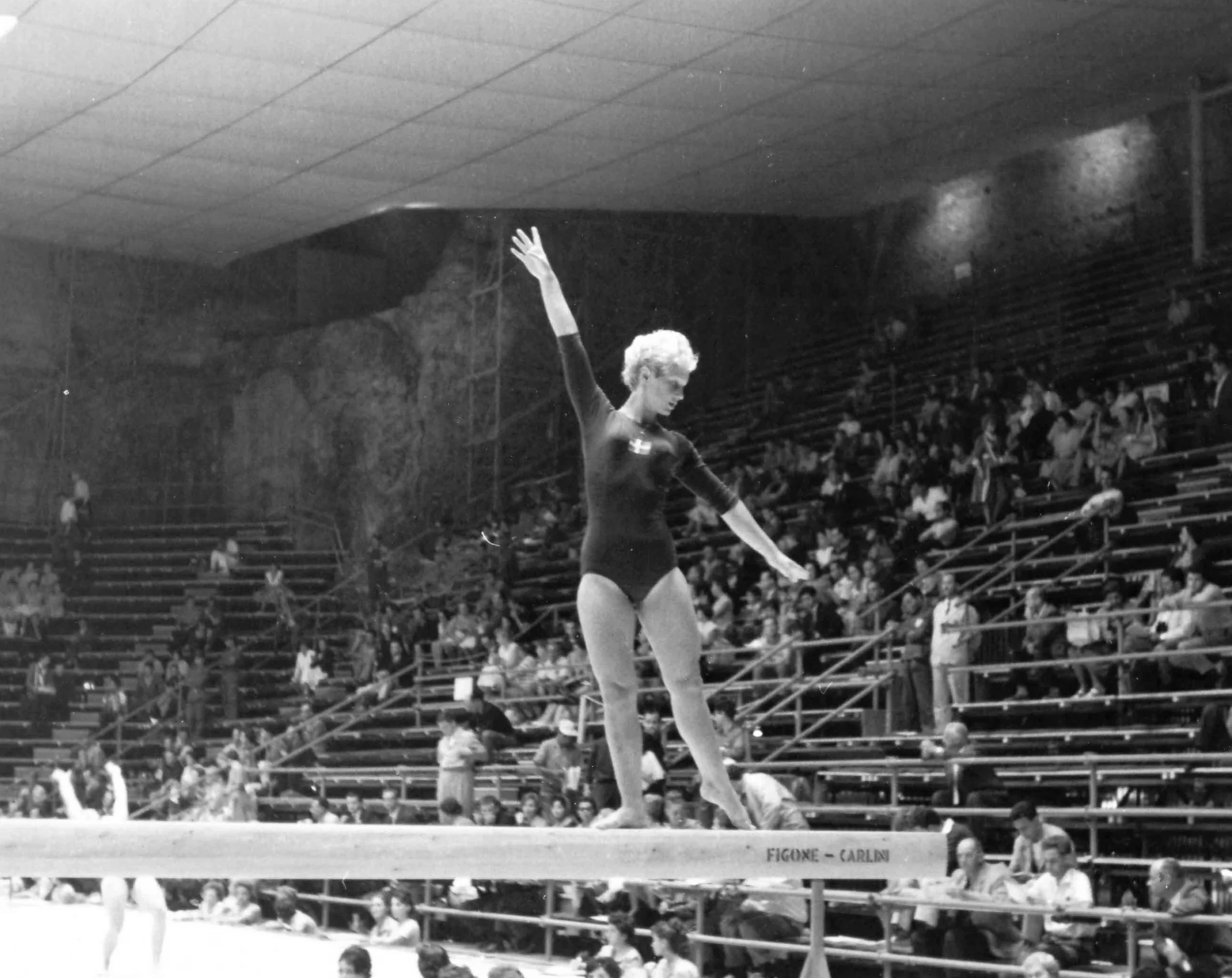
BACK TO ALL OLYMPICS
Est. 2018 | © GymnasticsHistory.co.uk 2025

